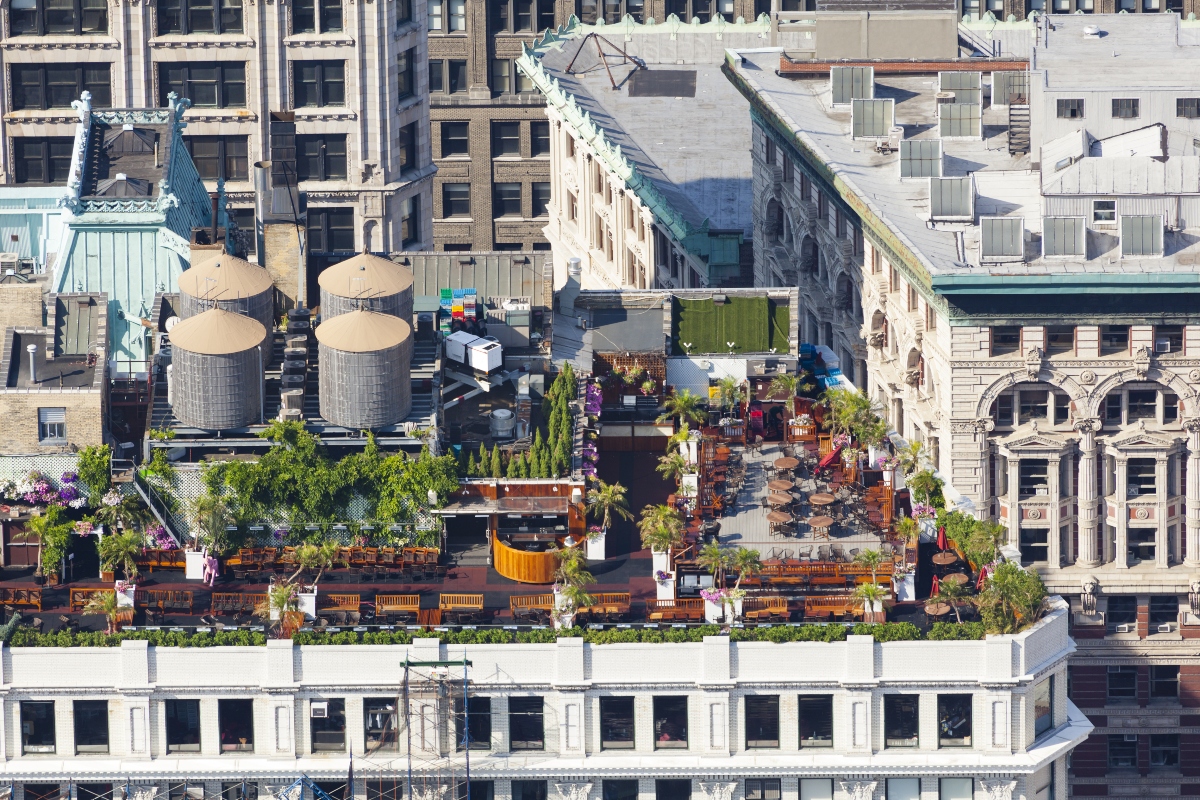How To Start Rooftop Gardening

When you live in a concrete jungle like New York City, Chicago, Los Angeles, or the like, you're accustomed to making the most out of the least when it comes to space — including green space. That's where a rooftop garden can help.
An unused roof may be the perfect spot to cultivate fruits, vegetables, flowers, trees, and shrubs.
What is a Rooftop Garden?
There are two main types of rooftop gardens (aka green roofs): extensive and intensive.
Extensive roofs typically consist of low-maintenance plants, such as wildflowers, ornamental grasses, and succulents. They're designed for environmental purposes only, rather than public participation and enjoyment.
Intensive roofs are what most people think of in terms of rooftop gardens. These outdoor spaces are created for city dwellers to contribute to and enjoy, while also providing environmental benefits.
Like traditional land-based gardens, intensive rooftop ones offer opportunities to grow diverse plant types, as well as create outdoor rooms, complete with seating, tables, and other features.
For the purpose of this how-to, we'll be focusing on the intensive type of rooftop gardening.
How to Start a Rooftop Garden
Sure, it's possible to grow all sorts of plants directly on a roof surface, but that's quite the undertaking for a handful of individuals. You would need experts to come in and install a waterproof membrane, root barrier material, and structural support.
Opting for a container garden (or using raised garden beds) is simpler and less expensive.
You'll need permission from the property manager, if you live in a rental or multifamily home. You'll also need supplies to start a rooftop container garden/
Containers
For rooftop gardens, it's best to avoid heavy containers made of clay and concrete, as they can potentially compromise the structural integrity of the roof itself. Instead, choose:
- Plastic
- Resin
- Wood
- Wicker
- Other synthetic materials
To save money (and the planet), you can even repurpose items you have lying around your house, such as old crates, coffee jars, and wading pools.
Other considerations to keep in mind include the size, color, and drainage of your pots. Experts at North Carolina State Extension say dark-colored pots can hold in more heat than light-colored ones, which can damage plants. When it's warm out, keep these types of containers out of direct sunlight.
It's also important to use containers that are large enough to handle a plant's growth and that have drainage holes. If no holes exist, you can either drill them yourself or double-pot your plants.
Raised beds are another option when growing your own rooftop garden and can be incorporated with other containers. And since raised garden beds cover more space than a single pot, you can plant various flowers, ground covers, herbs, and vegetables in one spot.
Soil and fertilizer
Just like the containers themselves, the soil inside must also be lightweight. Instead of heavy garden soil, opt for a soilless potting mix that includes ingredients such as peat moss, vermiculite, and perlite.
Since there's a finite amount of fertilizer in your potting mix, and much of it is absorbed as the plant grows and the soil drains, regular fertilization is necessary. Add slow-release formulas and lime every three to four months, or apply a liquid fertilizer every two weeks.
Water
Container plants need frequent watering, as they don't hold moisture long due to evaporation. Think about how you will be able to keep up an appropriate watering schedule. Will you have an irrigation system installed or will you hand water each plant one or two times daily?
Sunlight
Different plants have different light needs — some require full sun while others prefer partial shade. With a container garden, you can rotate pots to prime locations as needed.
Plants
For diversity in color, shape, and texture, choose a mix of annuals, perennials, small trees, and shrubs. Shrubs can also help provide privacy and protection against wind damage. Hardy, drought-tolerant plants that can thrive in sunny, windy, and hot or cold conditions will grow best.
A few other examples of plants to try in your urban environment are:
- Lavender
- Geraniums
- Salvia
- Impatiens
- Verbena
- Herbs
- Succulents
- Vegetables and fruits
- Ornamental grasses
- Dwarf boxwood shrubs and evergreen trees
Create a Rooftop Garden Design Plan
You already know variations in size, shape, texture, and color will create interest in your rooftop haven, but how exactly do you implement that knowledge?
For garden design ideas, take a look at commercial buildings, such as Chicago's city hall rooftop garden and the rooftop of the Metropolitan Museum of Art in Manhattan.
To create the full experience of an outdoor room on your living roof, add exterior lighting. This way, you can care for the plants, and simply enjoy the space, any time of day or night.
Possible lighting options include string lights, LED lights that line the floor of your roofing, and hanging lanterns.
Something to avoid: pavers and other hardscapes. They'll just soak up more heat and take away from the point of a living rooftop, which is the greenery.
Urban Rooftop Gardens: Other Things to Know
What are the benefits of rooftop gardens?
In urban areas, issues such as the Urban heat island effect, air pollution, and stormwater runoff pose problems for the health of people and the overall environment. Here's how installing green roofs can help lessen these problems:
- Green roofs can lower energy bills. Roofs absorb heat and that heat can seep down into the interior living spaces. As a result, people will run their air conditioning more. Rooftop gardens can alleviate this. New York City green environment experts say, "Plants provide natural cooling in several ways — by providing shade, by utilizing the sun's energy in photosynthesis, and, most importantly, by evapotranspiration," Evapotranspiration is "similar to perspiration," when plants turn water into vapor, they dissipate the latent heat of vaporization and provide cooling.
- Green roofs can reduce stormwater runoff. An urban garden cloaked in ground covers, flowers, small trees, shrubs, and other plant life will absorb rainwater that falls onto the roof, instead of allowing it to run off onto the ground, causing pollution and erosion. After using what they need, the plants will release any excess water as vapor back into the air.
- Green roofs can help improve air quality. Not only do plants absorb water, but they also absorb carbon dioxide to produce more oxygen. Living roofs also improve air quality by ridding the environment of other pollutants, such as nitrogen oxide, sulfur dioxide, carbon monoxide, and ground-level ozone. The EPA states that green roofs can cleanse the amount of pollution 15 cars produce in a single year.
How much does it cost to start a rooftop garden?
The EPA estimates the cost of an intensive rooftop garden can range from $15 to $25 per square foot.
Of course, small gardens will cost less than large ones, and you can lessen expenses by splitting costs with others you share the garden with or by purchasing less expensive (but still quality) containers, plants, and potting mixes.
What plants grow best in rooftop container gardens?
Choose hardy plants that thrive in containers and can handle a range of weather conditions. Examples include:
- Peppers
- Kale
- Collard greens
- Sedum
- Elephant ears
- Ficuses
- Irises
- Petunias
- Calla lilies
- Begonias
- Hostas
- Kousa dogwoods
- Japanese maples
- Eggplant
- Cucumbers
- Lettuce
- Oregano
- Tomatoes
- Thyme
- Sage
- Basil
- Cilantro
When to Call a Landscaping Pro
A landscape architect can survey the roof of your building to determine how much weight is safe to add, which will help you in selecting the types of containers and plants to use.
Or, if you'd rather stick to providing input on plant selection only, you can hire an expert to design and install your urban garden for you.
This way, you won't have to trouble yourself with how you'll get water to your roof, where to place what plants, what containers work best for drainage, and other potential issues. All you'll need to do is enjoy the space and take comfort in knowing you're contributing to the environment in a really great way.
Main Photo Credit: IndustryAndTravel / Adobe Stock

Andréa Butler
Descendant of the Fulani tribe, Gettysburg-obsessed Marine Corps brat, and lover of all things writing and editing, Andréa Butler launched Sesi magazine and has penned articles for sites, such as LivingSocial, Talbot Digital, Xickle, Culturs magazine, and Rachel Ray. Andréa holds a B.A. in English from the University of North Carolina at Greensboro and an M.A. in magazine journalism from Kent State University.
How To Start Rooftop Gardening
Source: https://www.lawnstarter.com/blog/landscaping/start-an-urban-rooftop-garden/
Posted by: tathamferamplon.blogspot.com

0 Response to "How To Start Rooftop Gardening"
Post a Comment